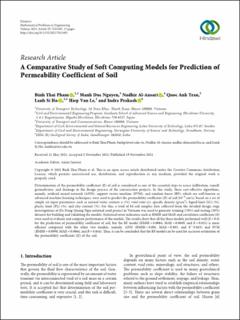| dc.description.abstract | Determination of the permeability coefficient (K) of soil is considered as one of the essential steps to assess infiltration, runoff, groundwater, and drainage in the design process of the construction projects. In this study, three cost-effective algorithms, namely, artificial neural network (ANN), support vector machine (SVM), and random forest (RF), which are well-known as advanced machine learning techniques, were used to predict the permeability coefficient (K) of soil (10−9 cm/s), based on a set of simple six input parameters such as natural water content (%), void ratio (e), specific density (g/cm3), liquid limit (LL) (%), plastic limit (PL) (%), and clay content (%). For this, a total of 84 soil samples data collected from the detailed design stage investigations of Da Nang-Quang Ngai national road project in Vietnam was used to generate training (70%) and testing (30%) datasets for building and validating the models. Statistical error indicators such as RMSE and MAE and correlation coefficient (R) were used to evaluate and compare performance of the models. The results show that all the three models performed well (R > 0.8) for the prediction of permeability coefficient of soil, but the RF model (RMSE = 0.0084, MAE = 0.0049, and R = 0.851) is more efficient compared with the other two models, namely, ANN (RMSE = 0.001, MAE = 0.005, and R = 0.845) and SVM (RMSE = 0.0098, MAE = 0.0064, and R = 0.844). Thus, it can be concluded that the RF model can be used for accurate estimation of the permeability coefficient (K) of the soil. | en_US |

